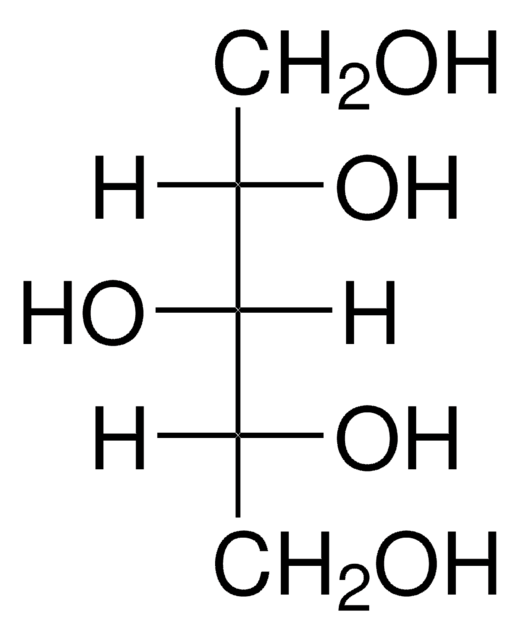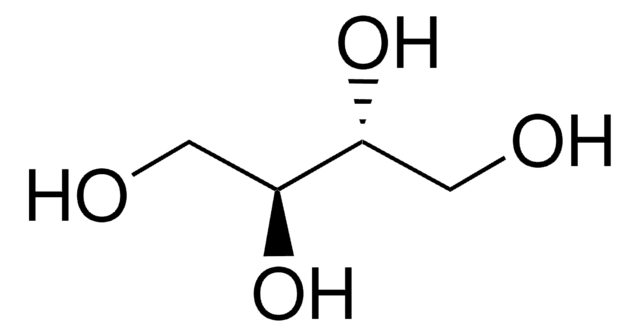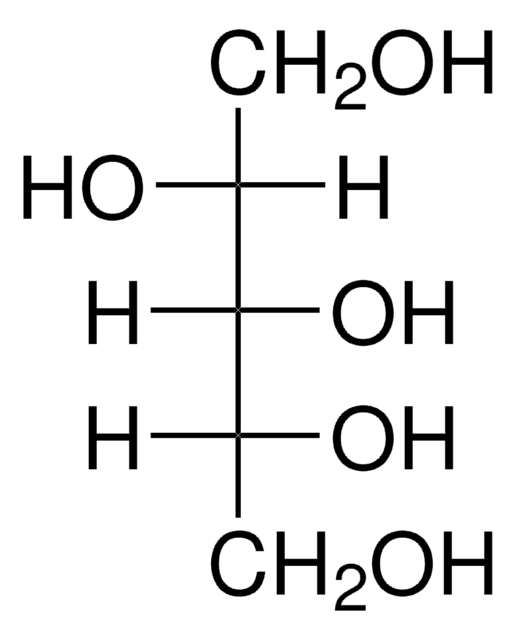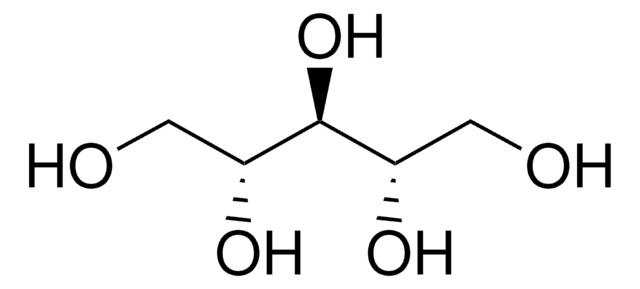About This Item
Fórmula linear:
HOCH2[CH(OH)]3CH2OH
Número CAS:
Peso molecular:
152.15
Beilstein:
1720523
Número CE:
Número MDL:
Código UNSPSC:
12352201
ID de substância PubChem:
NACRES:
NA.25
Produtos recomendados
Nível de qualidade
Ensaio
≥99% (GC)
Formulário
crystalline
crystals or chunks
powder
doçura
1 × sucrose
cor
colorless
pf
94-97 °C (lit.)
solubilidade
water: 642g/l at 25 °C (77 °F )
cadeia de caracteres SMILES
OC[C@@H](O)[C@H](O)[C@@H](O)CO
InChI
1S/C5H12O5/c6-1-3(8)5(10)4(9)2-7/h3-10H,1-2H2/t3-,4+,5+
chave InChI
HEBKCHPVOIAQTA-SCDXWVJYSA-N
Procurando produtos similares? Visita Guia de comparação de produtos
Descrição geral
Xylitol is a naturally occurring five carbon sugar alcohol, equivalent to sucrose in sweetness. Xylitol finds applications in the preparation of confectionaries, chewing gum, toothpaste and mouthwashes. Xylitol is a low-energy sweetener with insulin independent metabolism, making it a promising alternative for sugar in diabetic patients. Xylitol is a natural anticaries agent used in the treatment of dental caries, as it is not utilized by cariogenic bacteria creates a starvation effect on them. Xylitol prevents otitis and upper respiratory tract infections. Commercially, microorganisms like bacteria, fungi and yeasts produce xylitol by fermentation.
Aplicação
Xylitol has been used:
- as a standard for high performance liquid chromatography
- in analysing antibacterial activity on oral biofilms
- for thermodynamic data and densities measurement
Ações bioquímicas/fisiológicas
A sugar alcohol sweetener detectable by humans. Produced from hemicellulose hydrolysate fermentation.
Outras notas
To gain a comprehensive understanding of our extensive range of sugar alcohols for your research, we encourage you to visit our Carbohydrates Category page.
Código de classe de armazenamento
11 - Combustible Solids
Classe de risco de água (WGK)
WGK 3
Ponto de fulgor (°F)
Not applicable
Ponto de fulgor (°C)
Not applicable
Equipamento de proteção individual
Eyeshields, Gloves, type N95 (US)
Escolha uma das versões mais recentes:
Já possui este produto?
Encontre a documentação dos produtos que você adquiriu recentemente na biblioteca de documentos.
Os clientes também visualizaram
Synergistic effect of xylitol and ursolic acid combination on oral biofilms
Zou Y, et al.
Restorative dentistry & endodontics, 39(4), 288-295 (2014)
Molecular strategies for enhancing microbial production of xylitol
Pal S, et al.
Process Biochemistry (Oxford, United Kingdom), 51(7), 809-819 (2016)
Culture parameters affecting xylitol production by Debaryomyces hansenii immobilized in alginate beads
Perez-Bibbins B, et al.
Process Biochemistry (Oxford, United Kingdom), 48(3), 387-397 (2013)
Apparent molar volumes and apparent molar heat capacities of aqueous adonitol, dulcitol, glycerol, meso-erythritol, myo-inositol, D-sorbitol, and xylitol at temperatures from (278.15 to 368.15) K and at the pressure 0.35 MPa
Blodgett MB, et al.
The Journal of Chemical Thermodynamics, 39(4), 627-644 (2007)
Mette K Keller et al.
BMC oral health, 12, 44-44 (2012-10-25)
The increasing interest in probiotic lactobacilli in health maintenance has raised the question of potential risks. One possible side effect could be an increased acidogenicity in dental plaque. The aim of this study was to investigate the effect of probiotic
Nossa equipe de cientistas tem experiência em todas as áreas de pesquisa, incluindo Life Sciences, ciência de materiais, síntese química, cromatografia, química analítica e muitas outras.
Entre em contato com a assistência técnica







